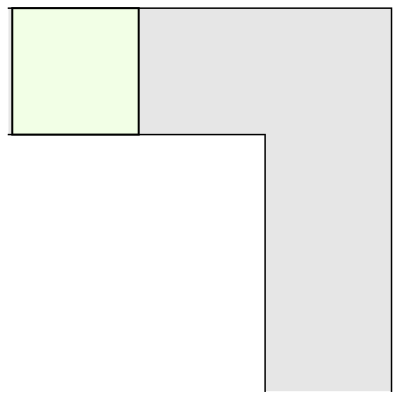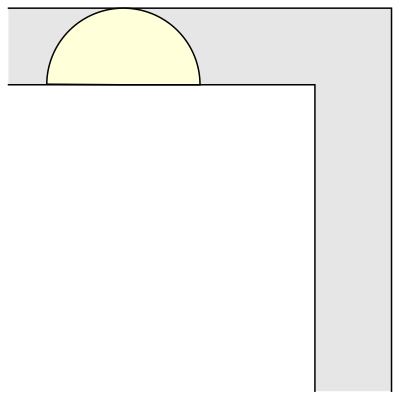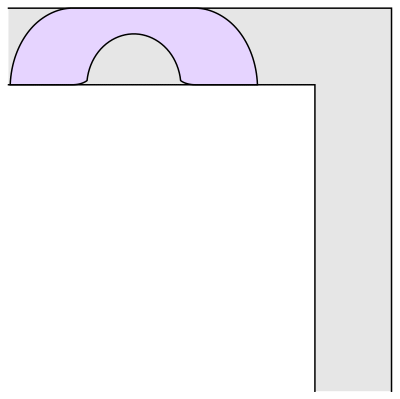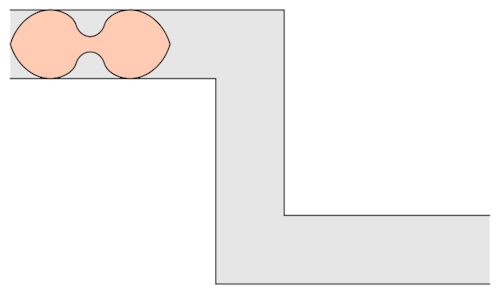Cool !
Cool !
More Posts from Matematicaulysses and Others




Scutoid
The newly discovered shape that shows how nature packs cells efficiently into three-dimensional structures.
Researchers have discovered a new geometric shape that’s been hiding in plain sight.
A team studying the cells that give rise to embryos and can be found lining our organs and blood vessels pinpointed a three-dimensional shape that occurs as they bend and pack together.
The new shape, dubbed the scutoid, allows these epithelial cells to organize with the most efficiency, as opposed to the column or bottle-like shapes scientists previously attributed to this process.

Treating a human head the way a globe is treated by the Mercator projection.

INTERNATIONAL KWEEN OF TRIGONOMETRY

Uma cidade perfeita para os exercícios de matemática!

Satellite map of Missoula, Montana
The regular hexagon hidden in a cube unfolds to a straight line on a net of the cube.

MATH SYMBOLS

If one remembers this particular episode from the popular sitcom ‘Friends’ where Ross is trying to carry a sofa to his apartment, it seems that moving a sofa up the stairs is ridiculously hard.
But life shouldn’t be that hard now should it?
The mathematician Leo Moser posed in 1966 the following curious mathematical problem: what is the shape of largest area in the plane that can be moved around a right-angled corner in a two-dimensional hallway of width 1? This question became known as the moving sofa problem, and is still unsolved fifty years after it was first asked.

The most common shape to move around a tight right angled corner is a square.
And another common shape that would satisfy this criterion is a semi-circle.

But what is the largest area that can be moved around?
Well, it has been conjectured that the shape with the largest area that one can move around a corner is known as “Gerver’s sofa”. And it looks like so:

Wait.. Hang on a second
This sofa would only be effective for right handed turns. One can clearly see that if we have to turn left somewhere we would be kind of in a tough spot.
Prof.Romik from the University of California, Davis has proposed this shape popularly know as Romik’s ambidextrous sofa that solves this problem.

Although Prof.Romik’s sofa may/may not be the not the optimal solution, it is definitely is a breakthrough since this can pave the way for more complex ideas in mathematical analysis and more importantly sofa design.

Have a good one!
![Luiz Sacilotto [Brazil] (1924-2003) ~ ‘C8752’, 1987. Acrylic And Watercolor On Canvas (89,9 X 89,9](https://64.media.tumblr.com/40c82f88341924d3fcbc082e17567b4f/eb064841902cbde7-25/s500x750/4dbb762516b03ffd04beef013f7eda5d415f17fb.jpg)
Luiz Sacilotto [Brazil] (1924-2003) ~ ‘C8752’, 1987. Acrylic and watercolor on canvas (89,9 x 89,9 cm).
Pois eu tbm tenho a dúvida se a partir do dia 17/12/2018 isso será permitido no TumBRL???
Now it’s time to play “is this a contour plot too racy for Tumblr?”

-
 erics53 reblogged this · 3 weeks ago
erics53 reblogged this · 3 weeks ago -
 cedrictheperipatetic liked this · 3 weeks ago
cedrictheperipatetic liked this · 3 weeks ago -
 transmasc-wizard liked this · 3 weeks ago
transmasc-wizard liked this · 3 weeks ago -
 approximately20eggs reblogged this · 3 weeks ago
approximately20eggs reblogged this · 3 weeks ago -
 cxlandine liked this · 3 weeks ago
cxlandine liked this · 3 weeks ago -
 rnschneider liked this · 3 weeks ago
rnschneider liked this · 3 weeks ago -
 colorful-queer-boi reblogged this · 3 weeks ago
colorful-queer-boi reblogged this · 3 weeks ago -
 polyblanke liked this · 3 weeks ago
polyblanke liked this · 3 weeks ago -
 thoughtsrunnigthroughmyhead reblogged this · 3 weeks ago
thoughtsrunnigthroughmyhead reblogged this · 3 weeks ago -
 enerdsout reblogged this · 3 weeks ago
enerdsout reblogged this · 3 weeks ago -
 alwek reblogged this · 3 weeks ago
alwek reblogged this · 3 weeks ago -
 lilapetrichorwinteryrogue liked this · 3 weeks ago
lilapetrichorwinteryrogue liked this · 3 weeks ago -
 h1h0w4r3y0u liked this · 3 weeks ago
h1h0w4r3y0u liked this · 3 weeks ago -
 enerdsout liked this · 3 weeks ago
enerdsout liked this · 3 weeks ago -
 crowwolf liked this · 3 weeks ago
crowwolf liked this · 3 weeks ago -
 funky-writer-man reblogged this · 3 weeks ago
funky-writer-man reblogged this · 3 weeks ago -
 funky-writer-man liked this · 3 weeks ago
funky-writer-man liked this · 3 weeks ago -
 crunchycrystals reblogged this · 3 weeks ago
crunchycrystals reblogged this · 3 weeks ago -
 cornmazehater reblogged this · 3 weeks ago
cornmazehater reblogged this · 3 weeks ago -
 nunyo-bizznez liked this · 3 weeks ago
nunyo-bizznez liked this · 3 weeks ago -
 egginfroggin liked this · 4 weeks ago
egginfroggin liked this · 4 weeks ago -
 accidental-gravitas reblogged this · 1 month ago
accidental-gravitas reblogged this · 1 month ago -
 necroanomaly reblogged this · 1 month ago
necroanomaly reblogged this · 1 month ago -
 miratriss reblogged this · 1 month ago
miratriss reblogged this · 1 month ago -
 miratriss liked this · 1 month ago
miratriss liked this · 1 month ago -
 ajfoxships liked this · 1 month ago
ajfoxships liked this · 1 month ago -
 quzq reblogged this · 1 month ago
quzq reblogged this · 1 month ago -
 quzq liked this · 1 month ago
quzq liked this · 1 month ago -
 oceanasky liked this · 1 month ago
oceanasky liked this · 1 month ago -
 breadismylifeline reblogged this · 1 month ago
breadismylifeline reblogged this · 1 month ago -
 scarletswalking reblogged this · 1 month ago
scarletswalking reblogged this · 1 month ago -
 skyleeasher liked this · 1 month ago
skyleeasher liked this · 1 month ago -
 risefromthesea-tothesky reblogged this · 1 month ago
risefromthesea-tothesky reblogged this · 1 month ago -
 elmermothsmithy reblogged this · 1 month ago
elmermothsmithy reblogged this · 1 month ago -
 elmermothsmithy liked this · 1 month ago
elmermothsmithy liked this · 1 month ago -
 linztheanimelover reblogged this · 1 month ago
linztheanimelover reblogged this · 1 month ago -
 linztheanimelover liked this · 1 month ago
linztheanimelover liked this · 1 month ago -
 quicklight-the-exister liked this · 1 month ago
quicklight-the-exister liked this · 1 month ago -
 tomboy014 reblogged this · 1 month ago
tomboy014 reblogged this · 1 month ago -
 chaos-creature-on-the-roof reblogged this · 1 month ago
chaos-creature-on-the-roof reblogged this · 1 month ago -
 manuscriptfire liked this · 1 month ago
manuscriptfire liked this · 1 month ago -
 mycelian-network liked this · 1 month ago
mycelian-network liked this · 1 month ago -
 cheekytown-official-0927 liked this · 1 month ago
cheekytown-official-0927 liked this · 1 month ago -
 the-later-fandom-historian liked this · 1 month ago
the-later-fandom-historian liked this · 1 month ago -
 fendetestas45 liked this · 1 month ago
fendetestas45 liked this · 1 month ago -
 anonymous-red-shades reblogged this · 1 month ago
anonymous-red-shades reblogged this · 1 month ago -
 2003s-greatest-horrorshow reblogged this · 1 month ago
2003s-greatest-horrorshow reblogged this · 1 month ago -
 2003s-greatest-horrorshow liked this · 1 month ago
2003s-greatest-horrorshow liked this · 1 month ago -
 thatoneluckybee liked this · 1 month ago
thatoneluckybee liked this · 1 month ago
Blog do profº Ulysses TDBueno destinado a curiosidades, demonstrações, links, trabalhos, artigos, imagens e tudo que possa mostrar a matemática no mundo.
107 posts